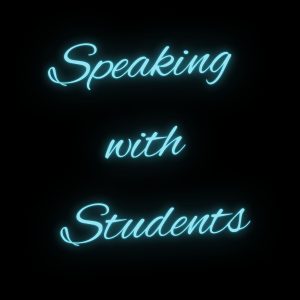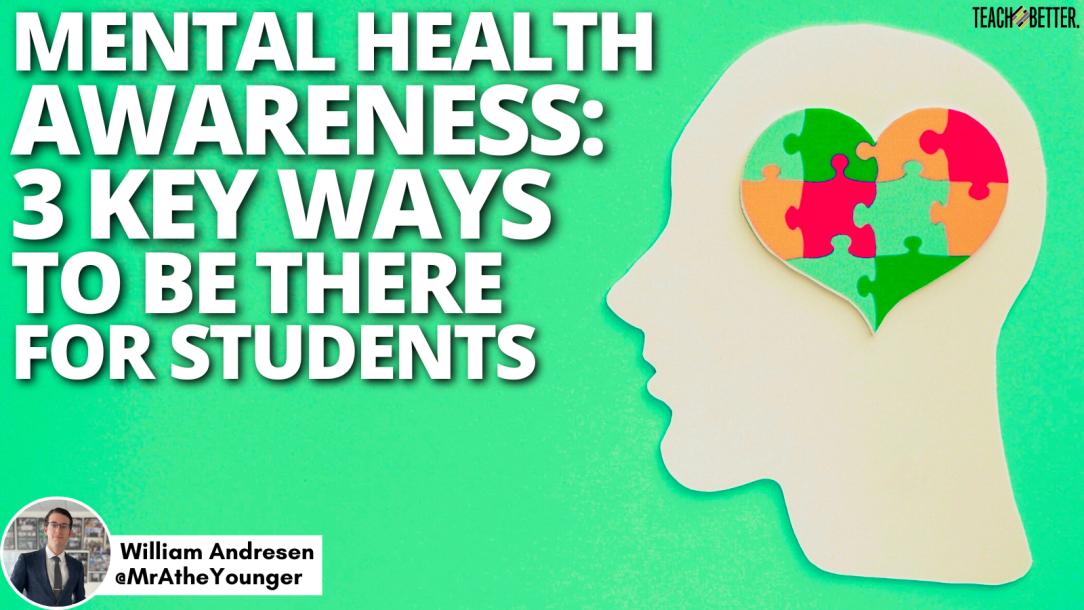TL;DR:
- Students need to feel visible and cared for.
- Say “hi” to each student, by name, every day. Educators who do this will create a small, but tangible and meaningful reminder for students that they are visible and cared for.
- Cheer students on. As educators, we have a wonderful opportunity to show up, demonstrate our interest in them as people, and cheer them on.
- Be present for students. Listen. Allow them to talk. Students often expressed having few adults in their lives who truly take the time to listen.
Mental Health Awareness
It can be difficult to show up each day for students. It can be overwhelming to think of the number of students in front of us each day in need of support or warmth. And it feels like that number grows with each day.
If teaching has taught me anything over my career, however, it is the elements of good listening. Beginning with the pandemic, and through subsequent years, I have listened carefully and taken in feedback and feelings as honestly as possible. And as a product of that process, I feel as though I have grown as a person to the point where I can be present for students in a way I once could not.
While it is overwhelming to think of the students who may need support each day, it continues to be a driving force for me—motivation for me and a motivator for how I show up for the students each day. So, when I considered topics I wanted to share with you through Teach Better, I thought of nothing more pressing nor central than, how to be there for students.
Earlier this year, I created a podcast called “Speaking with Students.”
The podcast consists of conversations between myself, an educator, and former students as they reflect on their academic experiences. I had the opportunity, just recently, to talk to two students whose particularly thoughtful responses sparked even more thought for me.
I wanted to use the opportunity, while still fresh, to share out three important ways we can be there for students each day. Three ways we can, above all, make students feel seen, visible, and cared for.
Mental Health Awareness Strategy #1: Say “hi” to each student, by name, every day.
Few actions are more central to my educational philosophy than this mantra, and that is to say hello to every student, by name, each day…in the hallway, at the beginning of class, and at the end of class. Often, students will remark on this routine by saying they are impressed to see a teacher remember and use everyone’s name each day. Even college students will express their appreciation. Beneath the positive feedback, however, I saw an equally frustrating observation. They were surprised that an educator remembered and used their names. Their reactions, over the years, seemed to suggest to me this was not a common occurrence. However, their reactions also seemed to suggest that it should be.
For one, it serves as a tangible, daily reminder to students that we care and we consider our time with them meaningful. Secondly, it can make a student feel visible in the building.
One detail of my conversation with a former student, Ray, stands out in particular when I discuss this point. He described a phase in his high school career where he was struggling emotionally, and recalled how it felt to walk through the building “in some ways almost irrelevant to the people around him.” This really reverberated for me, because I think I related to this feeling from when I was in high school. No student should feel invisible, and making the effort as an educator to say hi to each student, every day, can have a tremendous impact. Students need to feel visible and cared for. Educators who do this will create a small but tangible and meaningful reminder for students that they, indeed, are.
No student should feel invisible, and making the effort as an educator to say hi to each student, every day, can have a tremendous impact. Click To TweetMental Health Awareness Strategy #2: Cheer students on.
Students need to feel like they have someone in their corner. And having one adult who believes in them is reported to be one of the strongest indicators of success. School can be a powerful source of support for students when an adult takes an interest in them and believes in them.
We should acknowledge that it can be game-changing, and make it part of our repertoire as educators. This means making the effort to engage students in their interests. Taking the time to make conversation that engages the student as a person beyond their academics. In conversations with former students, these were some of the moments that most stood out in their recollections.
So, should a student share their own personal photography because they want you to see it, or if a student talks about a song lyric they are working on…these are powerful moments to be present and cheer students on. As educators, we have a wonderful opportunity to show up, demonstrate our interest in them as a person, and cheer them on in whatever they may set their mind to. This type of mentor behavior can be extremely impactful.
As educators, we have a wonderful opportunity to show up, demonstrate our interest in them as a person, and cheer them on in whatever they may set their mind to. Click To TweetMental Health Awareness Strategy #3: Be present for students.
Listen. Allow them to talk. Students often expressed having few adults in their lives who truly take the time to listen. And of course, we want to help, or provide advice, but sometimes that can turn into a lecture. Two strategies have had a major impact on my interactions with students.
The first is a realization.
When a student asks you a question about a topic or a current event, it is because they want to talk about it. Rather than providing an immediate response, treat the question like an opportunity to start a conversation. If you turn the question on the student and engage their opinion, you can create dialogue and allow the student the chance to express themselves. Furthermore, this type of behavior demonstrates that you care about their opinion, genuinely, and their interest is validated.
[scroll down to keep reading]
As for the second strategy, it is the use of a simple question. “Do you want to talk about it?” has been powerful for me.
When students share something with me that seems emotional, or sensitive, I will try to respond with this question. I have noticed that students will often have more they want to share, or more they want to talk about. Before putting yourself on the spot and responding immediately, ask students if they want to talk about it. This will signal ‘I am here to listen,’ and ‘I am here for whatever you may want to talk about.’
Before putting yourself on the spot and responding immediately, ask students if they want to talk about it. This will signal ‘I am here to listen,’ and ‘I am here for whatever you may want to talk about.’ Click To TweetDespite all of the professional development and training we endure, sometimes the best professional learning comes from the students themselves. Conversations with former students, both within the podcast and beyond, have been a powerful spark for reflection and improvement as an educator. These three ways we can be there for students each day can have a profound impact on young people. And isn’t that why we entered this field in the first place?
About William Andresen
William Andresen is a high school Social Studies and Film teacher from North Jersey, and a college professor. He holds a Master’s in Educational Leadership from Ramapo College of New Jersey. He prides himself on being an innovative educator and designs lessons and units that engage students through decision-making challenges, student-led discussions, and conceptual history. Will also serves as a GSA advisor and works to support students of the Pride community.
As an educator, he dedicates his energy and enthusiasm toward being a student-first leader in his academic community and aims to build long-term, meaningful relationships that empower students.
Beyond the classroom, Will created and hosts “Speaking with Students” – a new podcast series featuring conversations with former students as they reflect on their academic experiences. He is particularly proud of the way in which the podcast elevates student voice. When not thinking, reading, or talking about education, Will is a frequent reader of Presidential history, an avid runner, an accomplished bowler, and an obsessive fan of The Beatles.



